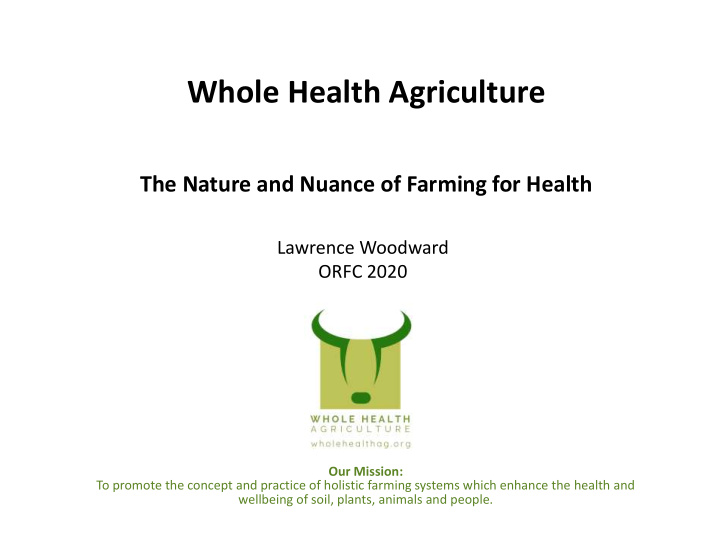



Whole Health Agriculture The Nature and Nuance of Farming for Health Lawrence Woodward ORFC 2020 Our Mission: To promote the concept and practice of holistic farming systems which enhance the health and wellbeing of soil, plants, animals and people.
Creating and Managing Positive Health ⚫ Talking about Health - not absence of disease ⚫ Health is a process (a dynamic) not a state ⚫ The health of soil, plant, animal and man (and the planet) is one and indivisible ⚫ Health can be infectious ⚫ In reality few people “ farm for health ” ⚫ Managing the process of health is little understood ⚫ But there are exceptions....... SHARE OUR AIM? ADD YOUR NAME! wholehealthag.org
The health of soil, plant, animal, man (and the planet) is one and indivisible • What is the mechanism or process by which the quality of health within the soil (or humus) could be transmitted to plants and then to animals and man? • If health is a dynamic process not “a state” how can that process be managed and optimised? • How can positive health be made to be “infectious”? • Why do some farms “ooze health” and others don’t? • Why is there so much variability in readily measureable parameters in organic food? • Missing link? – micro organisms, bacteria, energy, vitality, self – organisation? SHARE OUR AIM? ADD YOUR NAME! wholehealthag.org
One and Indivisible – the nature and nuance of positive health management • What is the mechanism or process by which the quality of health within the soil (or humus) could be transmitted to plants and then to animals and man? • What is the dynamic – energy, vitality, self – organisation? • Nature of the system: i.e. its primary characteristics and framework • The nuances of management: how the farmer maintains balance day to day and in the face of challenges SHARE OUR AIM? ADD YOUR NAME! wholehealthag.org
Principle of ecology This principle roots organic agriculture within living ecological systems. It states that production is to be based on ecological processes, and recycling. Nourishment and well-being are achieved through the ecology of the specific production environment. For example, in the case of crops this is the living soil; for animals it is the farm ecosystem; for fish and marine organisms, the aquatic environment. Organic farming, pastoral and wild harvest systems should fit the cycles and ecological balances in nature. These cycles are universal but their operation is site-specific. Organic management must be adapted to local conditions, ecology, culture and scale. Inputs should be reduced by reuse, recycling and efficient management of materials and energy in order to maintain and improve environmental quality and conserve resources. Organic agriculture should attain ecological balance through the design of farming systems, establishment of habitats and maintenance of genetic and agricultural diversity. Those who produce, process, trade, or consume Organic products should protect and benefit the common environment including landscapes, habitats, biodiversity, air and water. SHARE OUR AIM? ADD YOUR NAME! wholehealthag.org
Principle of Fairness Fairness is characterized by equity, respect, justice and stewardship of the shared world, both among people and in their relations to other living beings ………… ……… ..This principle insists that animals should be provided with the conditions and opportunities of life that accord with their physiology, natural behavior and well being. SHARE OUR AIM? ADD YOUR NAME! wholehealthag.org
SHARE OUR AIM? ADD YOUR NAME! wholehealthag.org
Why variability? climate, region, soil, farmer understanding and skill - organic systems are highly variable both within and between sites. 7.0 Participatory Trials Mean Wheat Yield in 2004 (t/ha@15%), LSD = 0.62 6.0 5.8 5.8 5.3 4.9 5.0 4.7 4.3 4.0 3.8 4.0 3.7 3.5 t/ha 3.0 3.0 2.5 2.4 2.3 2.3 2.0 1.0 0.0 A B C D E F G H I J K L M N O Site SHARE OUR AIM? ADD YOUR NAME! wholehealthag.org
The health process : A question of balance SHARE OUR AIM? ADD YOUR NAME! wholehealthag.org
The nature and nuance of health management Choosing species, breeds, crops, varieties according to landscape, soil type, and farming system requirements and physiology Trade off – production output and profile against crop quality, vitality, health, livestock wellbeing (production is not a measure of health; might be a measure of dis-ease) Outdoor/indoor – regional and cultural differences System changes: e.g housing, young stock rearing, water provision, balance of fertility building and cropping and cultivation/fertlisation Reduction of stress – how to observe stress and imbalance Building immunity, resilience, and animal and plant ’ s self- organisation and defence ability Interaction with biodiversity and functional diversity SHARE OUR AIM? ADD YOUR NAME! wholehealthag.org
Whole Health Agriculture Share Our Aim? Add Your Name! www.wholehealthag.org Our Mission: To promote the concept and practice of holistic farming systems which enhance the health and wellbeing of soil, plant, animals, people and planet SHARE OUR AIM? ADD YOUR NAME! wholehealthag.org
Recommend
More recommend